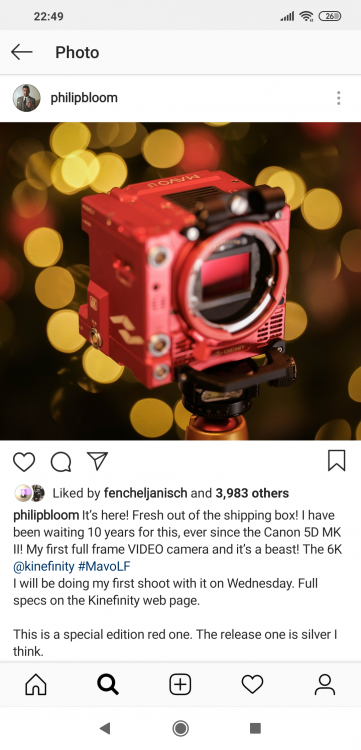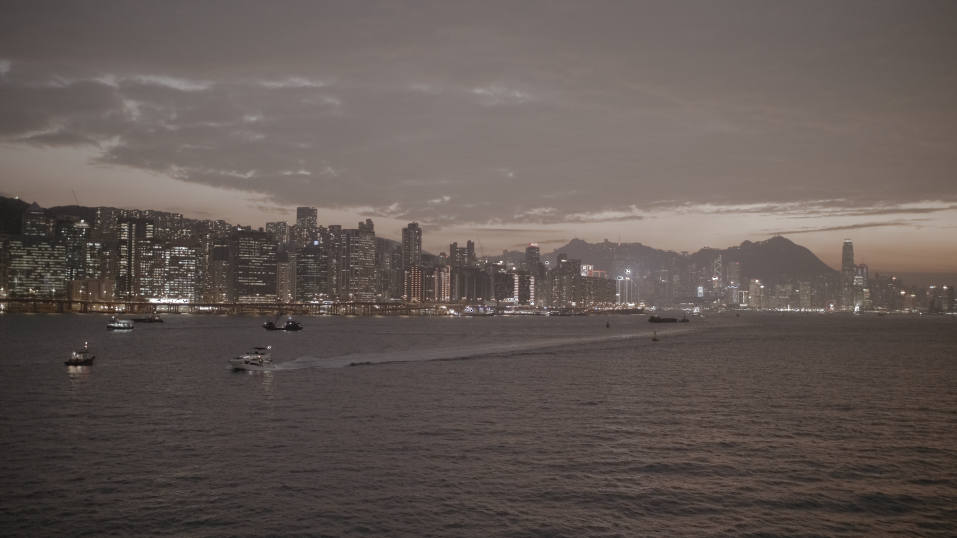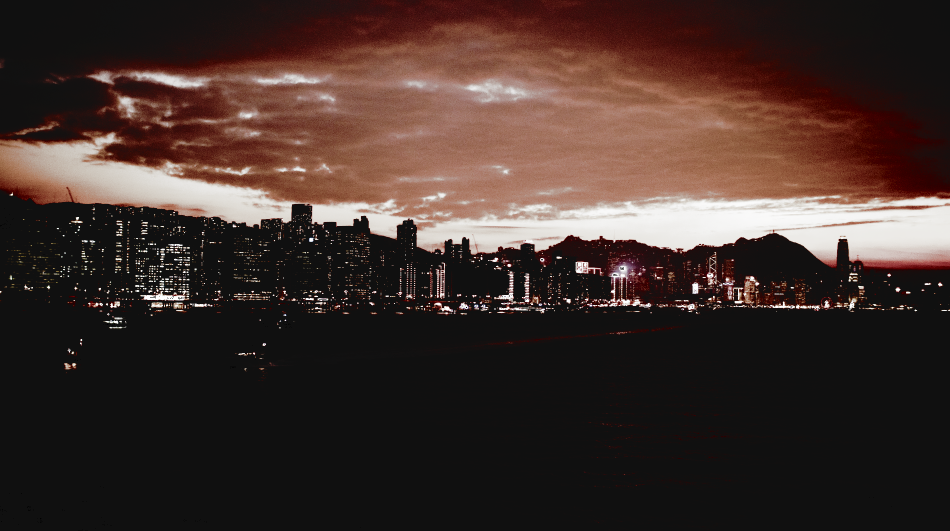-
Posts
7,885 -
Joined
-
Last visited
Content Type
Profiles
Forums
Articles
Posts posted by kye
-
-
-
28 minutes ago, kaylee said:
oh cmon. the american military is not attacking their own people – ever. whos operating these drones, the elite/nWo? what is it, trump with a ps4 controller?
they dont have different opinions, as far as this is concerned. and the cold war ended a long time ago, no one gives an f about putin, just another phony boogeyman
I'm confused. If the people need 100 million guns then who are they going to be fighting against? If it's anyone other than the US government then they'd either need a navy or snowshoes, and if it's someone to the south then they'll be completely screwed because there will be a great, impenetrable, beautiful wall in the way ???
-
1 hour ago, UncleBobsPhotography said:
USB 3.1 can also be used as displayport, but only has 10Gbit/s transfer rate compared to Thundersbolts 40Gbit/s. I would therefore image the issue is how to test if the connection has the full 40Gbit/s capabilities. I have no solution for this, but I would mention that USB-C/Thunderbolt has been a somewhat unreliable technology from my experience.
I have this kind of setup to connect my 4K Dell to my MBP via a cable.
In terms of testing it beforehand, I'm not sure how you would do that, but I also think that maybe you don't need to. If you get the RAID setup and it doesn't work with the ASRock Thunderbolt 3 at 40Gb/s then just return the ASRock and get something else that does work. Even if you have to bin it and buy another Thunderbolt card, you'd still lose less than buying your second RAID choice.
-
On 12/18/2018 at 6:51 AM, AlexTrinder96 said:
Every time I see a screenshot I always look at how much battery people have left. It's probably because my wife and kids are always screaming about having 2% left when we've only left the house 5 minutes ago, and I just wonder why they don't charge them while they're at home...
26% - that's considerably above average from what I see online, well done!
 1 hour ago, mercer said:
1 hour ago, mercer said:I really like what Kinefinity is doing. I have no idea what their cameras cost... I assume they’re out of my price range but I do like their image. Pleasing color, good DR and decent highlight rolloff with good codecs... what more do you need?
However, I think they are one company that could be well served with some sort of “pocket” version. I really like the idea of their 3K modes. I’ve always felt that really good 2K or 3K wasn’t optimized and really just skipped over for 4K... Arri’s 2.7K wasn’t arbitrary.
My impression is that they're kind of the "zero ergonomics modular camera" equivalent of early Blackmagic. They push what can be done for the money, but the question is if they're reliable. Most of the reviews I've seen online from previous models are from people who pre-ordered really early and are receiving the camera in the first batches. The reviews typically include a mixture of gorgeous footage from the Kinefinity, nice footage of them using the Kinefinity, and shaky iPhone footage from when the camera totally bricked itself and won't turn on again, followed by a narration about how it took an hour on the phone to tech support to reset it, or how they had to send the unit back and that's why the review took 6 weeks to film.
I think they've got a lot in common with the P4K in that naive people likely ordered based on specs and end up selling it when they realise the camera isn't waterproof (or something equally obvious to most people) so there might be some bargains around second-hand. However, I'd read a lot around how buggy the firmware is before parting with your money

-
14 minutes ago, androidlad said:
For high speed readout one has to sacrifice quality. The 4K 120p is 10bit ADC readout, which is very very low precision and high noise floor.
Is this to do with the mechanisms that combine the pixels together to down-res the output to 4K from the 8K sensor?
-
52 minutes ago, Snowbro said:
I started in Magento (2009ish), then got into WordPress. I just learned C#, now I am taking a course on "database theory" it will suck. I know how to create and use a database, but this is a fluff class, meant to trick you into failing haha.
I am often in -20c, -3 feels great ?
Did they cover fully-normalised databases yet? If someone says they've studied database design (in a programming context) and they don't know when a fully-normalised database is better than a semi-normalised database, then I just assume they're lying and/or don't know anything
 56 minutes ago, Snowbro said:
56 minutes ago, Snowbro said:I am often in -20c, -3 feels great ?
I think it's down to the clothing. @Kisaha also said "which for my country equals to Polar temperatures" which is true for me as well because we don't have clothing that is suitable for that kind of thing because it basically never happens! The wife and I are contemplating visiting Antarctica at some point, and apart from renting some really nice lenses I think I'd also rent some suitable clothing too

-
43 minutes ago, kaylee said:
we need tha guns for tha tyrannical government tho
if shit ever hits the fan with the US gov and yall find out whos really in control of things, youre going to be thanking god almighty that theres an army of 100 million gun owners in america
In a battle between the people with 100 million guns and the government, my money is on the side with the predator drones, not with the side who can't even talk about photography equipment online without getting into an argument.
- MacMurphy and Mark Romero 2
-
 1
1
-
 1
1
-
1 hour ago, webrunner5 said:
Yeah but doesn't the Z Cam E2 do like 4K 120p? So it seems like maybe it can be done?
Based on the Z Cam E2 already having done it, I'm also pretty certain it can be done.. ?
That's not the limit in terms of what is state of the art either... both the RED MONSTRO 8K VV and the RED HELIUM 8K S35 do 8K60, and in theory they should be able to pump enough pixels for 4K240, so either they didn't think anyone wanted it, or there's some other limitation.
-
2 hours ago, Kisaha said:
@kye i replied while I was in a difficult shooting with -3 degrees Celcious, which for my country equals to Polar temperatures, so maybe I did misjudged the statement.
I seriously respect ALL jobs, and I mean that with all my heart. All jobs are important, all people are important is my motto. Imagine if there was no cleaning service anywhere, no garbage collection, noone that make your clothes or put together the pieces on your phone and your camera to make them whole. People process our food, build our houses, clean our streets, service us in restaurants - and I have done some of those myself, so I know what is like.
In anyway, what makes this forum more interesting for me, is the knowledge and experience that working professionals share here. It is different to test a camera on your best friend's birthday party, and different than covering the event of a corporate client. Different when someone testing cameras on himself, on his spare room, and different when on a 50-100 people set for a major network. The weight of the decision gives weight to the opinion.
That is the difference with DPR, 1 in 1000 has a valuable information there, if most pro's leave eosHD, then it will become a more videocentric DPR.
No worries mate... -3 would make me pretty grumpy too!
All professions, huh? ALL professions? Really? Lawyers? Lobbyists? Hitmen? ..................Politicians? ???
-
What setup are you thinking of investing in?
-
1 hour ago, Mokara said:
Why? Cell phones have higher pixel densities than sensors used in micro 4/3 cameras. The only thing that would affect practicality is the power of the processor being used. If the most advanced processors currently available have a hard time doing 4K60p, then they probably can't do 8K30p. That is most likely what the Panasonic manager was saying, but it got lost in translation and comprehension.
Do Sharp have a processor capable of encoding a 8K30p stream in H.264 or H.265? Likely not, so if they do make such a camera it would probably use some relatively uncompressed encoding scheme. The picture of their camera shows a small body, it is dubious that thing will be capable of dealing with the heat from a high efficiency codec at 8K.
8K has four times the pixels of 4K, so 8K30 is equivalent to 4K120 in terms of pixels-per-second.
You might be right about less processor intensive processing but they'd have to be choosing from the options available in the marketplace which may not have a less-compression / higher bit rate option at the right price. Of course, if you were a microchip manufacturer then investing in the market for a 8K video compression chip isn't a risky proposition, and phones have been doing 4K60 with efficient power consumption and thermal loading for a few years now, so it's not like the tech is that far away.
-
35 minutes ago, IronFilm said:
Because camera buying is a religion and people gain a god like level of clarity as to which brand to worship.
Not realising that they should worship the art of photography or film-making and see the rest as tools.
I suspect that brand worship is a symptom of the amateur who loves the equipment and talking about it online and not the pros who are way too busy trying to balance the quality of their work with putting food on the table, but who knows...
-
39 minutes ago, thebrothersthre3 said:
100mm is twice as long as 50mm. The issue I have with mounting a long lens on a gimbal is movement. Gimbals are harder to control then simply holding something by hand. If you are just doing a static shot its fine but if you are trying to pan with the gimbal or move its really difficult.
I'm still unclear if the OP is using a 100mm lens or a 100mm equivalent lens.
I'm also a little surprised that you didn't get good results. I've only used a gimbal on my phone but it made smooth movement really easy to achieve. Maybe with a longer lens it would help to change to the slowest movement?
What was the problem you had? Was the pan speed uneven or did it not stabilise enough?
-
I used mine hand-held with a 58mm Helios on it, which is the equivalent of a 116mm lens on full-frame. That worked well when I was able to be reasonably steady but needed a bit of help when I was cold or had been active.
On a gimbal you shouldn't have any problems at all

-
No crop and it's really wonderful to use - I have used it handheld with long vintage lenses and it's worked really well.
Enjoy!
-
2 hours ago, Kisaha said:
This is very insulting for us that chose the other way around.
I breath images and sounds everyday, why do you believe this is lesser than what you do?
I consider myself lucky, being able to survive from film and video. When you do a project somewhere, you get concentrated knowledge and experience unlike most "normal" jobs I know.
No insult intended! Sorry if that's what it sounded like.
I sympathise for the struggles that the pros are experiencing with the changes in the industry, and in a sense I just have my struggles in a different industry. I've had my fair share of stress from work (or the lack of it) during my career and there is just as much criticism and commentary of my industry from those outside it as there is in photography I think.
We all live somewhere and holiday somewhere else, and we all work in one industry and have hobbies in other industries.
-
2 hours ago, liork said:
No, for that you need 12K.
8K is twice as wide as 4K, thus has 4X the pixels.
Maybe you're thinking of MP?
-
2 hours ago, User said:
Yes, this is statistically true. But my comment was more towards finding a way forward and towards a life with meaning that is financially sustainable.
I'm doing doc film - which I love - but it's pretty much a vow of poverty. Not to completely derail this thread but I'd be curious on how others here plan to keep their heads above the water in the years ahead?
I'm an amateur, as are many people here I believe, so I think we'll grapple with the changes that are likely occurring in our own industries, and visit the world of photography and film-making in our spare time and with the luxury of not having to survive from it.
-
8K - the only way to get a true 4K image!
- buggz, Rinad Amir and tellure
-
 3
3
-
Edit 2: I tried creating a new node, changing the mode to HSL and then setting the RGB mixer to the same settings as the faulty node, and it has similar but much worse behaviour, so I can't work out what it's doing.
-
2 hours ago, DanielVranic said:
in resolve you have to hit "options" during import and select "all files" and it will see it
Thanks! That was what I was missing

I've been playing with it for a while and I've noticed this "black sun" type problem:

This is coming from the HSL node, but the strange thing is that even if I go into the RGB mixer in the HSL node and reset everything to defaults, it is still there, and gets turned on and off when I enable or disable the node. This looks like a bug in Resolve to me rather than the RGB mixer in that node doing anything wonky.
But that's the only problem I can find. I even cranked the contrast to ridiculous amounts in a node in before the emulation nodes and it seems fine.
Original image + emulation nodes:

Stupid contrast + emulation nodes:

This is my GH5 in 4K 150Mbps 10-bit 25p mode with HLG.
Edit: I was using the WDR - Compound power grade for the above. I haven't played with the other ones yet.
-
A long shot, but I'm interested if Sony is going to update their X3000 action camera (the X3000 is their 4k30, 1080p120 action camera with IS). It was released late 2016 so might be due for a refresh?
Considering GoPro bet their farm on stabilisation and Sony has had optical stabilisation since 2016 it's a strange segment right now.
-
16 minutes ago, Snowbro said:
Dang, that is bad. I think that camera stores do not scale their human capital, according to demand. It took over 2 weeks for BH to process a return during this same time, they normally do it in a day.
I suspect you're right about them not scaling up. In a sense delays are inevitable, with the combination of goods getting cheaper and people buying more, and a faster pace of life with less planning combining with deliveries getting faster, and you've got the perfect recipe for a very intense and short spike in activity. If everywhere resourced up to meet that need you might need to have zero unemployment and everyone working 20-hour days for a week or so to compensate!
-
8 hours ago, DanielVranic said:
Did figure out the Juan Melara Linny LUT, looks like you have to into the PowerGrade's and tweak the HSL values to get it to not tear the footage.
On its own the Linny broke the color blue and some shades of red. With the HSL adjusted and then brought down in another corrector node, it works fine.
I will post tests soon.
Cool!
I downloaded the Powergrade and tried to test it on some GH5 footage but I couldn't install it. Resolve seemed to want different file types than what Juan had created, so I suspect it was a software version / backward compatibility issue. I googled a bit but didn't find any ready answers, and then got distracted.
I'm curious to see your results, but the original LUT 'look' didn't look that special to me, so I'm not that motivated TBH.







Panasonic GH5 - all is revealed!
In: Cameras
Posted
The GH5 is good but not great in low-light, therefore you want to use the fastest lenses you can get. This will also mean that your depth of field will be relatively shallow - unfortunately there is no way around this with this camera.
Your 12-60 f2.8 isn't a very fast lens. I would suggest either getting fast MFT lenses like the Voigtlander F0.95 series primes, or getting a speed booster and using something like the 18-35 f1.8. These will require manually focusing.
I recently filmed a lot with my GH5 at night using only the ambient available lights and I found that I really needed to use my Voitlander 17.5mm f0.95 with the aperture fully open at 0.95.
The alternative is to rent another camera setup that will have better low-light performance. Perhaps something like the A7SII or A7III with a 24-70 F2.8 lens. This setup would enable you to get noise-free shots with a deeper depth of field than the GH5/fast-lens combination.